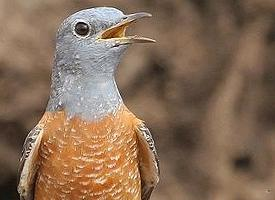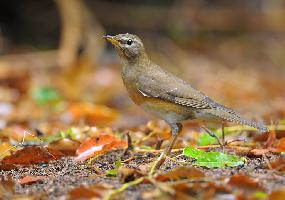
Greutăți și măsuri
| Lungime | de la 21 la 23 cm |
|---|---|
| Greutate | de la 50 la 80 g |
Descrierea animalului
The Redwing (Turdus iliacus) is a small passerine bird that is a member of the thrush family, Turdidae. It is characterized by its distinctive plumage and melodious song, which have made it a subject of admiration among birdwatchers and nature enthusiasts. The species is highly migratory, breeding across the northern regions of Europe and Asia, and wintering in southern Europe, north Africa, and parts of southwest Asia. This bird’s migratory patterns highlight its adaptability to varying climates and habitats, showcasing its resilience in the face of seasonal changes.Measuring approximately 20-24 cm in length with a wingspan of 33-34.5 cm, the Redwing is slightly smaller than its close relative, the Song Thrush. Its size and build are typical of thrushes, with a relatively slim body and long legs that it uses to forage through leaf litter and undergrowth in search of food. The Redwing's diet is varied and includes insects, earthworms, and berries, the latter becoming particularly important during the winter months when invertebrates are less available.
The most striking feature of the Redwing's appearance is its plumage. The upperparts are predominantly brown, providing excellent camouflage against the woodland floor, while the underparts are white with distinct dark brown spots, characteristic of many thrush species. Its name derives from the prominent reddish-orange flank patches, visible when the bird is in flight or displaying. Additionally, the Redwing has a conspicuous creamy white stripe above the eye and a dark brown eye stripe, which give it a distinctive facial appearance.
The Redwing's song is a beautiful, fluid melody, often described as a series of melodious phrases that are less structured than those of the Song Thrush but equally enchanting. During the breeding season, males can be heard singing from prominent perches, using their voices to attract mates and defend their territories. The bird's calls include a sharp "tseep" sound, which serves as an alarm call and is commonly heard during migration at night.
Breeding typically occurs from late April to July. The Redwing constructs a cup-shaped nest on the ground or low in bushes, where it lays a clutch of 4-6 pale blue eggs with brown spots. Both parents are involved in feeding the chicks, which fledge approximately two weeks after hatching.
Despite facing threats from habitat loss and changes in agricultural practices, the Redwing is currently listed as Least Concern by the International Union for Conservation of Nature (IUCN). Its widespread range and large population size offer some buffer against these pressures. However, continued monitoring and conservation efforts are essential to ensure that this beautiful and melodious bird remains a common sight across its range.
In summary, the Redwing (Turdus iliacus) is a small, migratory thrush known for its distinctive red flanks, melodious song, and adaptable feeding habits. Its presence enriches the biodiversity of the regions it inhabits, adding a splash of color and a symphony of sound to the landscapes it graces throughout the year.
Animale similare
Fotografii noi cu animale
Top 10 animale
- Dolphin gull (Leucophaeus scoresbii)
- Diana monkey (Cercopithecus diana)
- Moustached guenon (Cercopithecus cephus)
- Greek tortoise (Testudo graeca)
- Stone loach (Barbatula barbatula)
- Galápagos tortoise (Geochelone nigra complex)
- Japanese macaque (Macaca fuscata)
- Russian tortoise (Testudo horsfieldii)
- Common flying dragon (Draco volans)
- Galápagos penguin (Spheniscus mendiculus)


